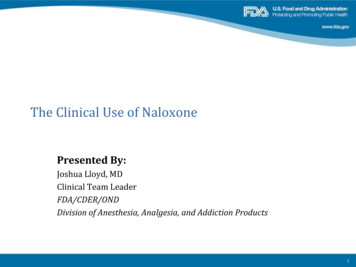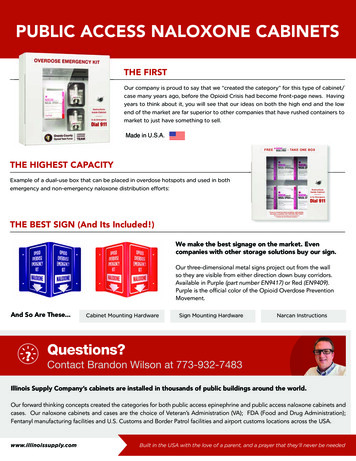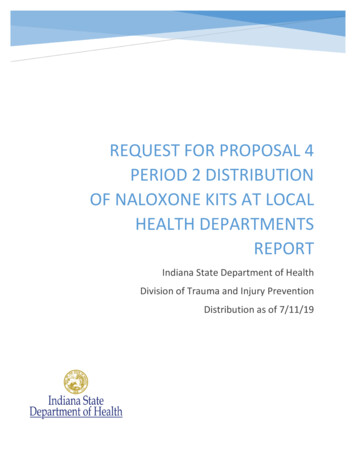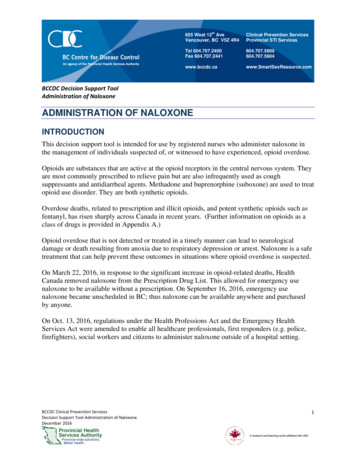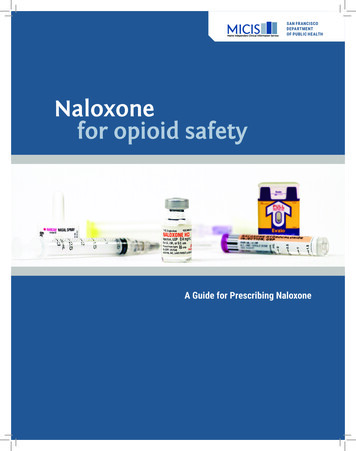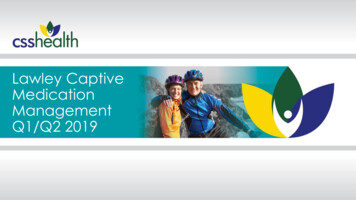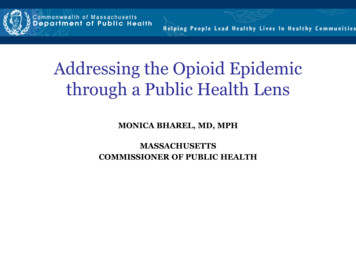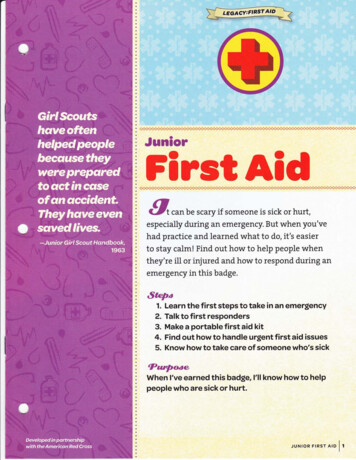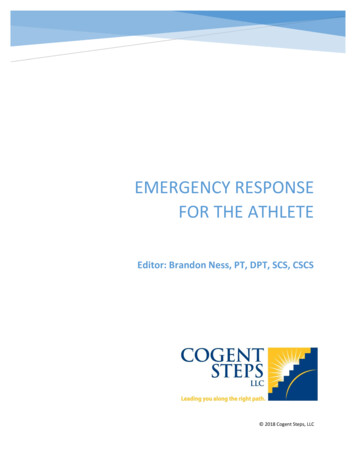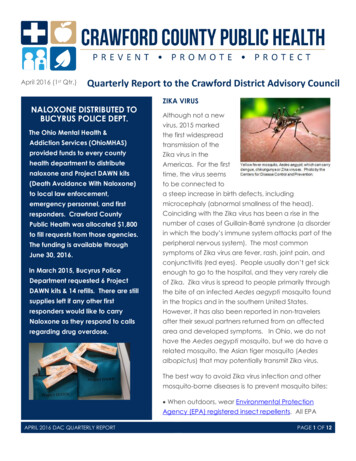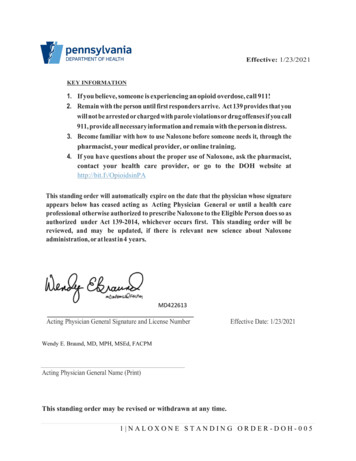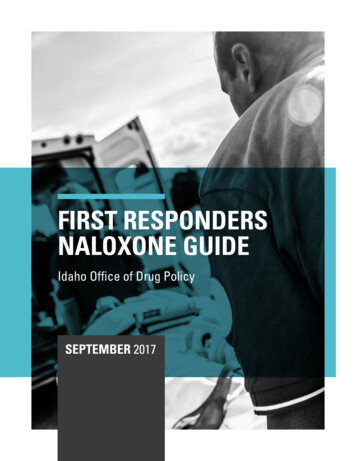
Transcription
FIRST RESPONDERSNALOXONE GUIDEIdaho Office of Drug PolicySEPTEMBER 2017
TABLE OF CONTENTS2 Introduction2 Opioid Overdose: Who’s at Risk2 The Connection Between Prescription Drugs and Heroin3 What is naloxone?3 How First Responders Benefit from an OverdoseReversal Program4Naloxone4 When to Administer4 Who Should Administer: Law Enforcement orEmergency Medical?4 How to Administer6 Side Effects6 Storage and Shelf Life6 Acquiring Naloxone6 Naloxone Grants8 First Responder Agency Considerations10Implementation10 Policies and Procedures10 Occupational Risks11 Training12Immunity13Community Collaboration and ResourcesThe Idaho Office of Drug Policy is providing this First Responders Naloxone Guide as a source of general information forIdaho’s first responders. The statements in this First Responders Naloxone Guide are not intended as any form of legal adviceand should not be construed as such. Any legal issues or questions should be discussed with the legal counsel for the firstresponder’s agency or other private legal counsel.Much of the information in this guide is from Engaging Law Enforcement in Opioid Overdose Response: Frequently AskedQuestions, by Leo Beletsky, JD, MPH. Beletsky’s document is the outcome of the July 31, 2014, U.S. Attorney General’sExpert Panel on Law Enforcement and Naloxone.Idaho Office of Drug PolicyFirst Responders Naloxone Guide1
INTRODUCTIONThe United States is in the midst of a public health crisis: Every year, more than 24,000 Americans diefrom opioid overdose. In 2015, in Idaho alone, there were at least 150 accidental drug-poisoning deaths,according to the Idaho Bureau of Vital Records and Health Statistics; that’s approximately one death everytwo days. Overdose caused by prescription opioids and heroin is now the leading cause of accidentaldeath, surpassing automobile accidents, AIDS, and other high-profile killers.This guide provides first responders with the knowledge and tools to reverse opioid overdoses in the field.It supports an initiative, announced by the federal government in October 2015, that recognizes opioidabuse as a national crisis and boosts public and private sector efforts to address it. Expansion of naloxonedispense and training programs are important components of this effort.Opioid Overdose: Who’s at RiskOverdose does not discriminate, reaching all geographic, economic, and racial divides. However, somegroups are more vulnerable than others. Veterans, residents of rural and tribal areas, newly releasedinmates, and those who have recently detoxed are more likely to die of an opioid overdose than the generalpopulation. Additionally, those with concomitant health issues—especially respiratory conditions—experience higher risk.The Connection Between Prescription Drugs and HeroinHealthcare providers wrote 259 million prescriptions for opioid pain medications in 2012—enough forevery American adult to have a bottle of pills.1 Opioids are a class of prescription pain medicationsthat includes hydrocodone, oxycodone, morphine, and methadone. The majority of opioid overdosesare accidental and result from taking inappropriate doses of opioids or mixing opioid drugs with othersubstances.Heroin belongs to the same class of drugs, and four in five new heroin users started out by misusingprescription opioid pain medications.21 Centers for Disease Control and Prevention, “Opioid Painkiller Prescribing,” CDC Vital Signs, July bing2 American Society of Addiction Medicine, Opioid Addiction 2016 Facts & Figures, rst Responders Naloxone GuideIdaho Office of Drug Policy
What is naloxone?An opioid overdose causes death by slowing and eventually stopping a person’s breathing. Naloxone,marketed as NARCAN and EZVIO , restores respiration within two to five minutes of being administered,and may prevent brain injury and death. Naloxone works on overdoses caused by opioids, which includeprescription painkillers and street drugs like heroin. Naloxone has no potential for abuse.Opioid poisonings typically take 45–90 minutes to turn fatal, creating a critical window of opportunity forlifesaving intervention. Across the United States, first responder agencies are increasingly training to carrynaloxone in an effort to stem the tide of overdose fatalities.How First Responders Benefit from an Overdose Reversal ProgramFirst and foremost, an overdose reversal program offers a potential lifesaving opportunity. Additionally,individual first responders have cited improved job satisfaction rooted in an improved ability to “dosomething” at the scene of an overdose. First responder agencies that have implemented an overdosereversal program report improved community relations, leading to better intelligence-gathering capabilities.Similarly, collaboration between law enforcement, public health, drug treatment, and other sectors onoverdose response initiatives lead to improved cross-agency communication, and helps take a public healthapproach to drug abuse.In 2015, in Idaho alone, there were at least150 accidental drug-poisoning deaths,according to the Idaho Bureau of VitalRecords and Health Statistics; that’sapproximately one death every two days.Idaho Office of Drug PolicyFirst Responders Naloxone Guide3
NALOXONEWhen to AdministerNaloxone only works on overdoses caused by opioids. Naloxone will not reverse overdoses resulting fromnon-opioid drugs like cocaine, benzodiazepines (“benzos”), or alcohol.However, in cases of multiple drug overdose (e.g., an opioid and a benzodiazepine), emergency respondersshould still administer naloxone, as it will remove the effects of the opioid and may reverse the overdose.If a person is unresponsive and it is not known whether opioids are the cause, it is standard practice toadminister naloxone just in case.Who Should Administer: Law Enforcement or Emergency Medical?Ideally, opioid overdose victims can receive timely attention from emergency medical responders. However,depending on the jurisdiction and the geographic setting, law enforcement officers may be in the positionto save lives by providing the initial emergency assistance—i.e., administering naloxone.Law enforcement, EMS, and fire agencies should collaborate as they develop their overdose rescueprograms, creating protocols that map how victim care will flow during an overdose response.How to AdministerFirst responders have three ways to administer naloxone:1) spraying naloxone into the nose (intranasal);2) giving a shot with a needle (intramuscular); or3) using an auto-injector, a prefilled, ready-to-use dose that is pressed against a person’s thigh.4First Responders Naloxone GuideIdaho Office of Drug Policy
INTRANASALIntranasal (IN) is currently the most common method.This can be delivered in one of two ways: 1) Adapt Pharma’sNARCAN Nasal Spray is preloaded and ready for immediateuse. 2) Responders can use a product in which they connecta naloxone vial to an atomizer device that converts thenaloxone liquid into a fine mist.INTRAMUSCULAR INJECTIONIntramuscular injection (IM) has been used in medicalsettings for decades. Many community-based preventionprograms distribute IM naloxone to families and otherpotential opioid overdose bystanders because of its lowercost. With IM, naloxone is drawn from a vial into a syringeand then injected into the victim’s upper arm, thigh, orbuttocks.AUTO-INJECTOREVZIO is an auto-injector that provides step-by-stepinstructions using voice prompts and visuals printeddirectly on the device. Its fully retractable needle systemis designed to eliminate the risk of NSI. EVZIO’s retailprice is substantially higher than IN or IM products, butthe manufacturer, kaléo, offers a discount program to lawenforcement agencies.Idaho Office of Drug PolicyFirst Responders Naloxone Guide5
NALOXONESide EffectsNaloxone may result in acute opioid withdrawal (agitation, nausea, vomiting, diarrhea, “goose flesh.”tearing, runny nose, and yawning). When victims experience these symptoms, they may become irritableand anxious. It is uncommon, however, for the revived victim to become violent or combative. Intranasalnaloxone delivery is less likely to result in severe withdrawal symptoms than an injection.On rare occasions, reviving an opioid overdose victim may restart existing health problems or uncover theeffect of other drugs the victim had taken. This may result in heart palpitations or seizures. In all cases ofoverdose, it is critical victims be transferred to the care of medical professionals.Storage and Shelf LifeNaloxone is a fairly stable medication, with a shelf life between 18 months and two years. IN naloxoneshould be stored between 59 and 77 degrees Fahrenheit; IM naloxone between 58 and 86 degrees. EVZIOmaintains stability at temperatures of up to 104 degrees for six months. Avoid storing naloxone in extremehot or cold environments.In most first responder settings, naloxone can be stored in the cab of the vehicle or with automatedexternal defibrillator (AED) units during a shift. Naloxone should not be left in the vehicle long-term,and should instead be properly stored inside the agency facility. Naloxone kits can be maintained bythe individual responders or, alternately, issued at roll call and checked in at the end of the shift. Uponexpiration, supplies of the medication should be replaced.Acquiring NaloxoneNaloxone is a prescription medication, but it is not a controlled substance. This means authorization isneeded to allow possession and administration of the drug by first responders. In most cases, a protocolcalled a “standing order” can be issued for an entire department by any provider holding a license to writeprescriptions.Naloxone GrantsThe Idaho Office of Drug Policy (ODP) has a standing order on file for distribution to all first responderswho are awarded ODP First Responder Naloxone Grants. These grants provide funding for the purchaseof naloxone kits and training first responders in their usage. The simple grant application can be found quest. For more information, contact Sharlene Johnson atsharlene.johnson@odp.idaho.gov or (208) 854-3048.6First Responders Naloxone GuideIdaho Office of Drug Policy
Idaho Office of Drug PolicyFirst Responders Naloxone Guide7
FIRST RESPONDERAGENCY CONSIDERATIONSShould every first responder agency implement an overdose rescue program?All agencies should consider whether overdose rescue is appropriate as a potential tool, based on theirrole, jurisdiction, and design of emergency medical services. Overdose reversal training and naloxonesupply are particularly beneficial to rural, tribal, and other high-risk settings where professional emergencymedical response may be significantly delayed by geographic, resource, and other factors. Not all agencieswill incorporate overdose rescue, and may focus instead on other prevention and treatment efforts likecommunity education; prescription drug take-backs; and encouraging high-risk groups to seek help.The way law enforcement conducts itself during overdose response events is critical to communityperceptions of—and partnership with—the agency. Officers who create a culture of trust between firstresponders and members of the public maximize the chances bystanders will call 911 during overdoseevents. Basic outreach at the scene can help educate families, friends, and other bystanders to be vigilantfor signs and symptoms of overdose, since many victims experience more than one such event over theirlifetime.8First Responders Naloxone GuideIdaho Office of Drug Policy
Idaho Office of Drug PolicyFirst Responders Naloxone Guide9
IMPLEMENTATIONPolicies and ProceduresAlthough not mandated, it is strongly recommended that in-house policies and protocols are in placeregarding the appropriate use of naloxone: steps to be taken upon administration; follow-up care protocols;proper disposal of used, expired, or adulterated units; and proper reporting procedures.The Idaho Office of Drug Policy strongly recommends in-house policies state that prompt medicalassistance must be summoned at the scene of an overdose and that only those who have completedapproved online training may administer the medication. ODP features videos on naloxone administrationon its website, www.odp.idaho.gov, and can provide technical assistance to first responders in carryingnaloxone. Please feel free to contact ODP with questions at (208) 854-3040.Each agency is encouraged to establish standard operating procedures (SOPs) for overdose responseactivities. These procedures should be drafted in consultation with the governing laws of the jurisdiction.If applicable, policies should integrate the provisions of relevant 911 Good Samaritan laws, as well as thedepartment’s policy on information gathering, searches, arrests, and other activities at the scene of anoverdose. Any triage plans developed with EMS and fire agencies can also be reflected in the SOPs.Sample Policies and Procedures DocumentODP has created a sample document that Idaho law enforcement and emergency medical servicesagencies can download and customize. It is available at s/sites/33/2017/09/LEA-Naloxone-Policy.pdf.Please direct questions to Sharlene Johnson at sharlene.johnson@odp.idaho.gov or (208) 854-3048.Occupational RisksProviding first aid to an opioid overdose victim carries the same general occupational risk inherent to otherfirst-aid activities. Given that a substantial proportion of opioid overdose victims are people who injectdrugs, first responders should be aware of the high likelihood that hypodermic needles may be present onthe victim’s person and elsewhere on the scene.Injection of intramuscular (IM) naloxone carries a remote risk of an accidental NSI. If the responderexperiences an NSI after administering the drug, there is a risk of contracting a blood borne infection suchas Hepatitis C or HIV. Aftermarket atomizers enable intranasal administration of naloxone without usinga needle. Most agencies have determined that the added expense of purchasing atomizers is worth theoccupational safety gains from not having to use needles to administer the drug. The retractable needlesystem of the EVZIO auto-injector is designed to prevent needle stick injury.10First Responders Naloxone GuideIdaho Office of Drug Policy
Overdose victims rescued by naloxone may experience opioid withdrawal symptoms. In very rare instanceswhen such symptoms are severe, the victim may become combative. This is reported in about one percentof all rescues.TrainingOverdose response program trainings typically last from 40 to 90 minutes. At the very least, trainingincludes three basic elements: 1) how to recognize signs of an opioid overdose, 2) how to provide basic lifesupport and proper administration of naloxone, and 3) an opportunity to practice skills.Most trainings also cover some combination of the following content: Drug abuse basics, including the chronic nature of addiction Mechanisms by which opioids can cause overdoses and the reversal properties of naloxone Occupational safety considerations Legal considerations, including naloxone authorization and applicable Good Samaritan laws or policyprovisions covering overdose victims and bystanders Standard operating procedures for the administration of naloxone Overdose education and naloxone distribution programs available to community members Substance abuse treatment resources available in the jurisdictionPrograms that meet best practices cover information and skills that equip first responders to engage inprevention and treatment program referral. The particular mix of training content and delivery channelsdepends on local needs and circumstances. Employees who hold existing medical response certificationssuch as CPR or basic life support may require an abridged training.Please check the ODP website at https://odp.idaho.gov for future naloxone training sessions.Idaho Office of Drug PolicyFirst Responders Naloxone Guide11
IMMUNITYIdaho House Bill 108, signed by Governor Butch Otter in 2015, provides reassurances to a 911 caller thatthey cannot get in trouble for witnessing and reporting an overdose. This is designed to encourage friendsand loved ones to seek emergency medical services as soon as they suspect an overdose is occurring.Here is the text:54-1733B.(2) Notwithstanding any other provision of law, any person acting in good faith and exercising reasonablecare may administer an opioid antagonist to another person who appears to be experiencing an opiaterelated overdose. As soon as possible, the administering person shall contact emergency medicalservices.(3) Any person who prescribes or administers an opioid antagonist pursuant to subsection (1) or (2) ofthis section shall not be liable in a civil or administrative action or subject to criminal prosecution forsuch acts.12First Responders Naloxone GuideIdaho Office of Drug Policy
COMMUNITY COLLABORATIONAND RESOURCESIn many communities, law enforcement overdose response programs help create a united front in the fightagainst overdose and other drug-related issues. Law enforcement officers already play a leadership role incross-agency collaboration and information-sharing in the domain of drug abuse. Law enforcement officersalso frequently come into contact with hard-to-reach populations most at risk of opioid overdose. Local andregional opioid overdose taskforces can collaborate with criminal justice, public health, judicial, and otherresources in creating a comprehensive response to this ongoing crisis using promising practices.Examples of promising programs include:Multi-agency public education campaignsThese larger initiatives often receive heightened media coverage and result in improved awareness aboutopioid overdose and its prevention.Programs to encourage opioid overdose witnesses to seek helpMany opioid overdoses are witnessed, but bystanders do not call 911 because they do not recognize thesigns and symptoms of an overdose, or because they are concerned about legal repercussions.Targeted education and outreach to high-risk groupsVeterans, residents of rural and tribal areas, recently-released inmates, people completing drug treatment/detox programs, and some young adults are at an especially high risk of opioid overdose. Law enforcementand correctional officers are uniquely positioned to engage in initiatives targeting these high-risk groups,thereby helping prevent fatalities by engaging in outreach initiatives. Individuals re-entering society after aperiod of incarceration are especially vulnerable. In the first two weeks, formerly incarcerated individualsare approximately 30 times more likely to die of a drug overdose than members of the general public. Anumber of programs engage law enforcement and correctional staff in educating this population aboutoverdose risk, how to avoid and respond to overdose, and any provisions covering criminal liability of thosewho seek help.Warm HandoffsState agencies are researching implementing a warm handoff process whereby overdose survivorsare transferred directly from the emergency department to a drug-treatment facility. Once the model iscomplete, ODP will work with stakeholders to encourage implementation.Idaho Office of Drug PolicyFirst Responders Naloxone Guide13
COMMUNITY COLLABORATIONAND RESOURCESPharmacy take-back programsA recent survey released by CVS Health found that one in three people in the US report having unusedmedication in their home, and one in five say they or someone they know has had prescription medicationstolen from their home. This data leads experts to believe that one contributing factor to the prescriptiondrug abuse issue is pervasive availability to pain medication, typically obtained from a home medicinecabinet.In response, the Drug Enforcement Administration expanded the options available to collect controlledsubstances from ultimate users for the purpose of disposal through the Secure and Responsible DrugDisposal Act of 2010. The Disposal Act allows for ultimate users to transfer prescription medications toretail pharmacies for disposal. Studies have shown that prescription drug drop-box programs can be aneffective strategy in combating prescription drug abuse. A two-year study of prescription medication dropboxes placed in a rural area concluded that “drug donation boxes can be an effective mechanism to removecontrolled substances from community settings” (Gray, Hagemeier, Brooks & Alamian, 2015). Researchersfurther assert that pharmacies are an “ideal venue to collect and destroy” unused prescription medications(Garey, Johle, Behrman & Neuhauser, 2004).ODP and the Idaho Board of Pharmacy (IBOP) believe that increasing the number of medication disposallocations throughout the state will decrease the amount of prescription medication available for misuse,abuse, and diversion. ODP and the IBOP provide mini-grants to pharmacies throughout the state toimplement a prescription drug drop-box program. The application can be found at ini-grant-application.For more information, contact Sharlene Johnson at sharlene.johnson@odp.idaho.gov or (208) 854-3048.14First Responders Naloxone GuideIdaho Office of Drug Policy
Idaho Office of Drug PolicyFirst Responders Naloxone Guide15
Idaho Office of Drug Policy(208) s
responder's agency or other private legal counsel. Much of the information in this guide is from Engaging Law Enforcement in Opioid Overdose Response: Frequently Asked Questions, by Leo Beletsky, JD, MPH. Beletsky's document is the outcome of the July 31, 2014, U.S. Attorney General's Expert Panel on Law Enforcement and Naloxone.
